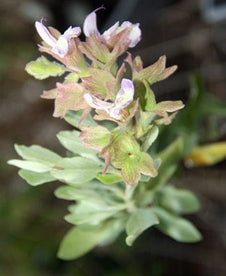



Salvia dolomitica
Salvia dolomitica

- Low stock - 19 items left
- Inventory on the way

Usually available: All year
Life cycle: Perennial
Height: 1 - 1.5m
Position: Full sun
Soil preference: Well drained
This is how we pack and send your Herb Plants to all states except TAS & WA
You will receive
- 1 Salvia dolomitica Herb Plant in a 50 X 75mm tube - General growing instructions
All of our Herb Plants are grown organically with certified organic potting mixes and fertilizers
Botanical Name: Salvia dolomitica
Salvia dolomitica is a hardy, medium sized evergreen, perennial shrub with aromatic leaves. In Australia this plant reaches around 1 meter high by 50cm to 1 meter wide, but in its native habitat it may reach up to 1.8 meters. Cooler regions of the world report growth of about 60cm by 60cm, so this may apply to your local conditions. The spring to summer blooms are lilac edged lobes to white throats, with a yellow dotted beeline to guide bee pollination. The calyces are a burgundy colour and turn a rusty pink after flowering. The fragrant leaves start as a fresh green, with a dense coverage of fine hairs and age to a grey green. The leaves are egg or ovate shaped, with a wedge at the base, have an entire margin and taper to a point. The stems also have fine hairs and appear as if emerging from the rootstock.
Salvia dolomitica is also known as Dolomite Sage in Australia. However, there are many references to Pilgrim’s Rest Pink Sage in this salvia’s native South Africa. The plant grows exclusively in rocky, dolomitic outcrops from 1000-1900 meters elevation, in a small and limited range near Pilgrim’s Rest River in the Mpumalanga and Limpopo Provinces in the eastern and central region of South Africa. This historic location was where pilgrims following the 1873 gold rush would seek refuge. The colour of the calyces is acknowledged by a reference to Pink Sage.
There are 27 salvias that have been identified in South Africa. S. dolomitica is thought to be one of the oldest, because it is one of few that are bee pollinated. In the evolutionary timeline, the more recent species have evolved with tubular flowers designed to be probed and pollinated by birds.
The salvia family has over 900 members with an extensive history as culinary, medicinal and ornamental plants. Ornamental salvias have become collectors items, as gardeners try to find a place in their garden for each and every one. There are salvias that will suit every type of soil and climate. More information on the Salvia genus and Common Sage (Salvia officinalis) may be found on our Common Sage page.
Growing Conditions
Salvia dolomitica is a hardy plant tolerant of a wide range of conditions, despite having evolved in a restricted native habitat. It prefers full sun, but will tolerate partial shade at some point during the day. It is a heat and drought resistant plant but will flourish with regular watering and well drained, composted soil. This salvia evolved in mild winters, but reportedly handles low level frost well. It is considered to be a good container plant.
Dolomite Salvia is considered to be a fast grower, although its final size may be affected by local weather conditions. As noted earlier, this salvia may grow quite large in South Africa but is likely to be smaller in the home garden. It is a bushy plant that branches from basal root stock by sending up multiple stems. As the stems thicken, so does the plant. Cutting back after flowering or bi-annually in winter will help to encourage a bushy plant with new growth. Seeds are produced but propagation is by tip cuttings of semi-hardwood cuttings in spring or summer.
All information provided on this website is for informational purposes only. Please seek professional advice before commencing any treatment.






